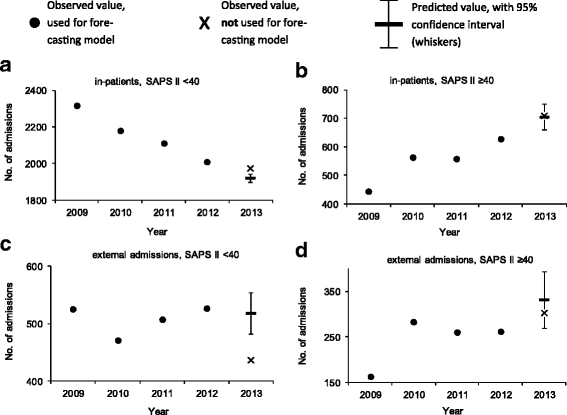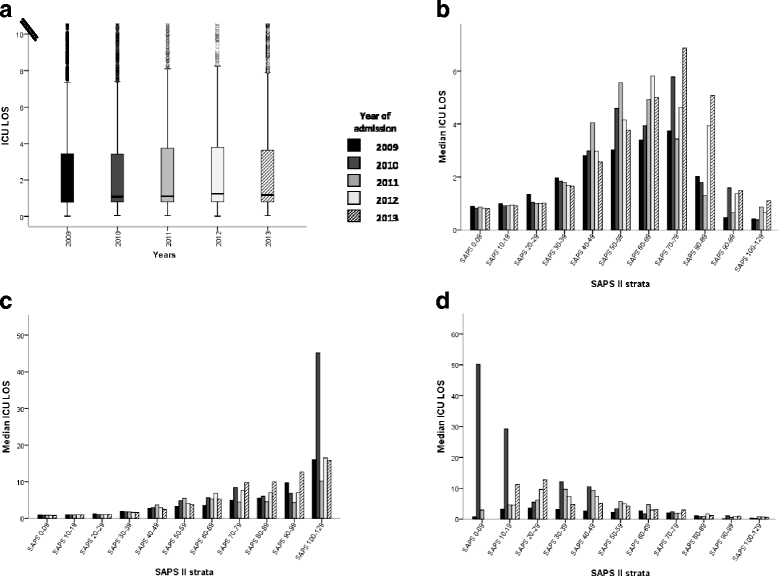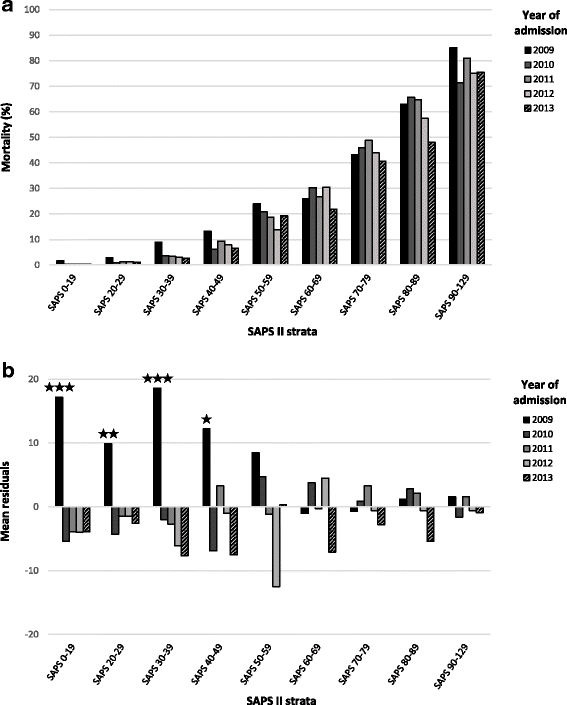Effect of diagnosis related groups implementation on the intensive care unit of a Swiss tertiary hospital: a cohort study
- PMID: 29402271
- PMCID: PMC5800035
- DOI: 10.1186/s12913-018-2869-4
Effect of diagnosis related groups implementation on the intensive care unit of a Swiss tertiary hospital: a cohort study
Abstract
Background: In 2013 the Swiss Diagnosis Related Groups ((Swiss)-DRG) was implemented in Intensive Care Units (ICU). Its impact on hospitalizations has not yet been examined. We compared the number of ICU admissions, according to clinical severity and referring institution, and screened whether implementation of Swiss-DRG affected admission policy, ICU length-of-stay (ICU-LOS) or ICU mortality.
Methods: Retrospective, single centre, cohort study conducted at the University Hospital Zurich, Switzerland between January 2009 and end of September 2013. Demographic and clinical data was retrieved from a quality assurance database.
Results: Admissions (n = 17,231) before the introduction of Swiss-DRG were used to model expected admissions after DRG, and then compared to the observed admissions. Forecasting matched observations in patients with a high clinical severity admitted from internal units and external hospitals (admitted / predicted: 709 / 703, [95% Confidence Interval (CI), 658-748] and 302 / 332, [95% CI, 269-365] respectively). In patients with low severity of disease, in-house admissions became more frequent than expected and external admission were less frequent (admitted / predicted: 1972 / 1910, [95% CI, 1898-1940] and 436 / 518, [95% CI, 482-554] respectively). Various mechanisms related to Swiss-DRG may have led to these changes. DRG could not be linked to significant changes in regard to ICU-LOS and ICU mortality.
Conclusions: DRG introduction had not affected ICU admissions policy, except for an increase of in-house patients with a low clinical severity of disease. DRG had neither affected ICU mortality nor ICU-LOS.
Keywords: DRG; Diagnosis related groups; Epidemiology; ICU admissions; Switzerland.
Conflict of interest statement
Ethics approval and consent to participate
This observational trial complies with the current version of the Declaration of Helsinki and the national legal and regulatory requirements, and has been approved by the Canton Ethics Committee (Kantonale Ethikkommission Zurich, Switzerland, KEK-ZH-Nr. 2014–0452).
Consent for publication
According to the Ethics Committee no specific consent for the study was required given that the study was performed with an anonymized set of data i.e. without individual data.
Competing interests
The authors declare that they have no competing interests.
Publisher’s Note
Springer Nature remains neutral with regard to jurisdictional claims in published maps and institutional affiliations.
Figures



Similar articles
-
Intensive care unit length of stay: recent changes and future challenges.Crit Care Med. 2000 Oct;28(10):3465-73. doi: 10.1097/00003246-200010000-00016. Crit Care Med. 2000. PMID: 11057802
-
Emergency Department Length of Stay for Critical Care Admissions. A Population-based Study.Ann Am Thorac Soc. 2016 Aug;13(8):1324-32. doi: 10.1513/AnnalsATS.201511-773OC. Ann Am Thorac Soc. 2016. PMID: 27111127
-
Adverse outcomes after planned surgery with anticipated intensive care admission in out-of-office-hours time periods: a multicentre cohort study.Br J Anaesth. 2018 Jun;120(6):1420-1428. doi: 10.1016/j.bja.2018.02.063. Epub 2018 Apr 13. Br J Anaesth. 2018. PMID: 29793607
-
Patients admitted via the emergency department to the intensive care unit: An observational cohort study.Emerg Med Australas. 2019 Apr;31(2):225-233. doi: 10.1111/1742-6723.13123. Epub 2018 Jul 11. Emerg Med Australas. 2019. PMID: 29998569
-
[Main results of the Swiss study on DRGs (Casemix Study)].Soz Praventivmed. 1989;34(4):156-66. doi: 10.1007/BF02080405. Soz Praventivmed. 1989. PMID: 2508347 Review. French.
Cited by
-
Practicality of Acute and Transitional Care and its consequences in the era of SwissDRG: a focus group study.BMC Health Serv Res. 2019 Jun 13;19(1):374. doi: 10.1186/s12913-019-4220-0. BMC Health Serv Res. 2019. PMID: 31196075 Free PMC article.
-
The Impact of a New Case-Based Payment System on Quality of Care: A Difference-in-Differences Analysis in China.Risk Manag Healthc Policy. 2024 Dec 11;17:3113-3124. doi: 10.2147/RMHP.S488825. eCollection 2024. Risk Manag Healthc Policy. 2024. PMID: 39676828 Free PMC article.
-
Evaluating the impact of the diagnosis-related groups payment system on laparoscopic uterine fibroid surgery outcomes: insights from a single-center study.Front Public Health. 2025 Jun 10;13:1555444. doi: 10.3389/fpubh.2025.1555444. eCollection 2025. Front Public Health. 2025. PMID: 40556909 Free PMC article.
-
Ultrasound-Guided Pudendal Nerve Block in Patients Undergoing Open Hemorrhoidectomy: A Post-Hoc Cost-Effectiveness Analysis from a Double-Blind Randomized Controlled Trial.Clinicoecon Outcomes Res. 2021 Apr 28;13:299-306. doi: 10.2147/CEOR.S306138. eCollection 2021. Clinicoecon Outcomes Res. 2021. PMID: 33953578 Free PMC article. Clinical Trial.
-
Differences in inpatient performance of public general hospitals following implementation of a points-counting payment based on diagnosis-related group: a robust multiple interrupted time series study in Wenzhou, China.BMJ Open. 2024 Mar 12;14(3):e073913. doi: 10.1136/bmjopen-2023-073913. BMJ Open. 2024. PMID: 38471900 Free PMC article.
References
-
- Eidgenössisches Departement des Innern EDI - Bundesamt für Statistik BFS - Schweizerische Eidgenossenschaft. Gesundheitsstatistik 2012. Neuchâtel; 2012. https://www.bfs.admin.ch/bfsstatic/dam/assets/348071/master. Accessed 29 Jan 2018.
-
- Bundesamt für Statistik BFS - Website Statistik Schweiz. Kosten des Gesundheitswesens nach Leistungserbringern, Periode 1995–2012 (je-d-14.05.02.01). http://www.bfs.admin.ch/bfs/portal/de/index/themen/14/05/blank/key/leist.... Accessed 22 Jan 2015.
-
- Schweizerische Eidgenossenschaft . Bundesgesetz über die Krankenversicherung (KVG) (Spitalfinanzierung), Aenderung vom 21. Dezember 2007. 2007.
-
- Schweizerische Eidgenossenschaft - Bundesamt für Gesundheit BAG - Bern. Medienmitteilungen. https://www.admin.ch/gov/de/start/dokumentation/medienmitteilungen.msg-i.... Accessed 22 Jan 2015.
Publication types
MeSH terms
Grants and funding
LinkOut - more resources
Full Text Sources
Other Literature Sources

